The Floating Reed Rig
Introduction
HAVING RETURNED TO fishing after 20 years absence the lessons learned long ago are gradually starting to float back to me. Being ostensibly a river fisherman the closed season has a habit of dragging by but any fishing is better than no fishing so a couple of weeks ago I set off for the lake on a tench expedition.
The lake bed was thick with weed and the water so coloured that I found it impossible to find any clear bottom to fish on. After losing two hooklengths in the first three casts I believed that the day was destined to be an expensive one. I thought about how, if ever, I had got over the problem in the early years. Then quick as a flash it all came flooding back to me…
My first experiences of fishing were on canals around my home in Ashton-Under-Lyne and Bardsley Vale. Apart from 2ft of water and a few mixed species of fish these canals contained everything from old bedsteads and cars to dead sheep and in the summer months the bottoms were 9 inches deep in dense weed.
We could only afford to buy a couple of hooks a week and a few maggots and losing both those hooks to snags in the first half hour of fishing was a disheartening experience for a keen nine year old fisherman.
We soon discovered that when legering in and around weed with a small Arlesley bomb the bomb always came back but the hook invariably snagged. So it followed that we had to find a way to fish just above the weed. We experimented with lollipop sticks first but this gave us the problem that you had first to buy a lolly and if you did that you didn’t have the money for two hooks and some maggots. Next came bird feathers but the problem was always the same, how to attach the hooklength and anyway they just looked wrong somehow.
After much experimentation this is what I came up with and I rarely lost a hooklength in a weedbed again.
The Stillwater floating Reed Rig
Reeds are formed from longitudinal fibres which are very strong when in sheer and in tension. They are also extremely buoyant, You will be very surprised by how much weight is required to keep the rig on the bottom and you will find that if you are fishing fairly close in with an upright rig that as you pay out line the reed will float to the surface like a polaris float enabling you to clearly see the bait as it pops to the surface. A decently made rig can last for hours of continual casting and retrieval as often happens when feeder fishing. And as long as the fibres don’t shear with line pressure it can last through several catches.
A simple reed or stem of grass, anchored at the base, will always float vertically in the water. These are just a few of the reeds and grasses that you usually encounter at the bank side:
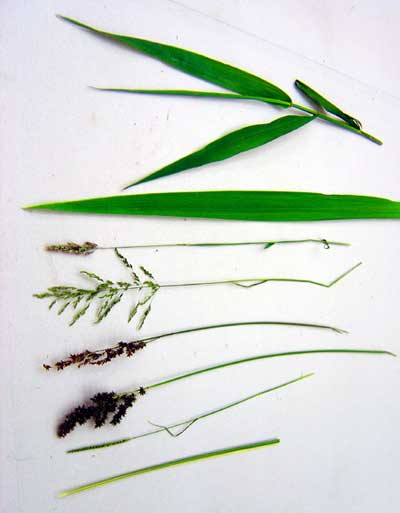  Reed Rig 1 |
In the following description I have used red sewing thread and a number 10 hook for colour differentiation and scale.
To construct the most basic or these rigs you will need a hooklength, a fine baiting needle and a reed of your choice.
Simply push the baiting needle through the reed close to the tip.
Pull a loop of the hooklength back through the reed.
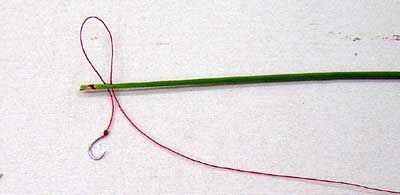  Reed Rig 2 |
Pull in the hook to the required position and take a loop around the end of the reed, either around the shank of the hook to keep it upright, or just round the reed allowing the hook to fall down the side of the reed.
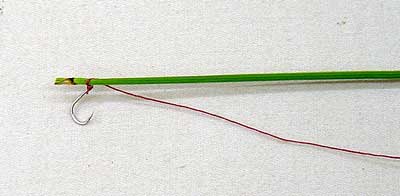  Reed Rig 3 |
Next, twist the reed between your fingers and spiral the line around the reed until you get as far down the reed as required. Push the baiting needle through the reed again and pick up the line pulling it back through the reed the same as before and take another loop around the bottom of the reed.
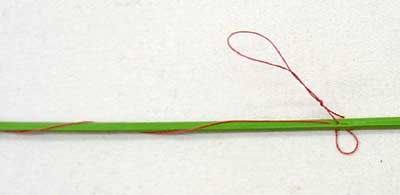  Reed Rig 4 |
Trim top and bottom as required and the rig is complete. It is completely knotless so if the reed gives way under the pressure of a fighting fish the line simply straightens out and the reed floats away.
  Reed Rig 5 |
Now simply attach your hooklength to the reel line by means of the line terminator and you have a perfect stillwater floating rig.
How the rig will present in the water:
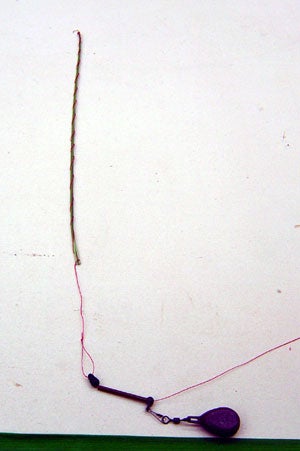  Reed Rig 6 |
In this simple form the rig can be made to present itself in a number of forms, either in a vertical form or by simply creasing the reed and adding a split shot to form a paternoster as shown below.
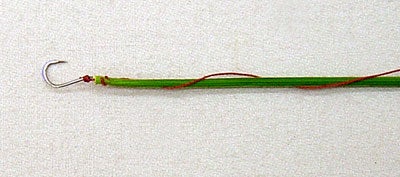  Reed Rig 7 |
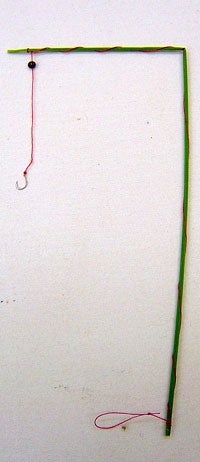  Reed Rig 8 |
Vary the length of the reed to the depth you need to fish above the bottom.
Different reeds and grasses will obviously have different levels of buoyancy so you can use a particular type of reed or grass to match line weight, hook size and required leger of feeder weight.
If you are fishing the margins for carp you may want to use the paternoster rig to lay on the top of the water with the bait hanging a couple of inches below the water underneath the spear end of a large Water Iris reed. Alternatively a 1lb bs hooklength will require a fine grass.
Here are some alternatives to start the ball rolling. All you need to do now is to apply this technique to your particular style of fishing.
A fine grass rig with the hook nestling in the seed head
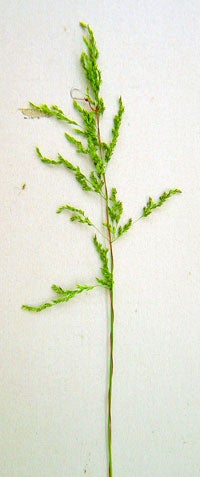  Reed Rig 9 |
Another reed with the bait sitting on the side (ideal for margins)
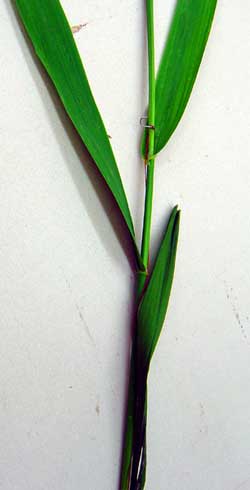  Reed Rig 10 |
A Water Iris reed paternoster (ideal for carp margin fishing)
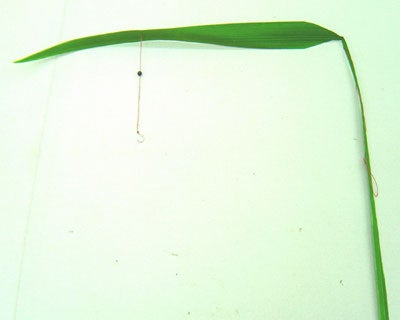  Reed Rig 11 |
The Iris reed paternoster is shaved back to the stiff centre core with the top of the read left as a spear. It is then folded and weighted to form a canopy over the bait. The example here is exactly as the rig will present in the water.
This reed, depending on how long you make it, can take anything up to an ounce to hold bottom and about three SSG shot to stop the spear head from lifting.
With an upright rig the fish naturally tries to release the bait from the reed and in doing so achieves two things. The first is an inability to swallow the bait as it cannot swallow the reed. The other is a propensity for the rig to be self-hooking as it gently tries to pull the bait away.
Advantages of the rig
- Perfect camouflage
- Completely natural in presentation
- Completely knotless
- Completely free of charge
- No more snagged lines in weedy swims
- No danger of the fish swallowing the hook on an upright rig
- Vvirtually self-hooking
Disadvantages
- Bad news for people who make expensive paternosters
- Can’t think of any more
You may be interested to know that I blanked on the tench expedition. The rig worked fine though. No more lost hooklengths for me.










